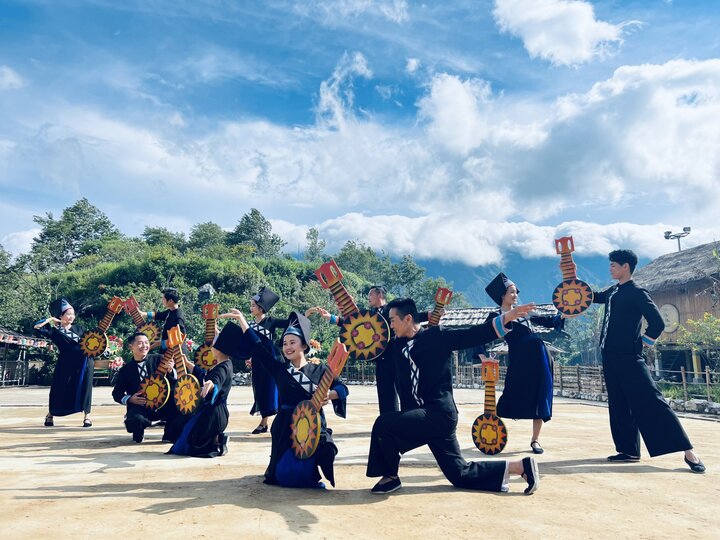1. Unlocking the potential from the treasure trove of 'living heritage'
At an altitude of 1,200 – 1,800m above sea level, Sa Pa National Tourist Area possesses cool and clear air year-round. Many tourists liken this place to having a 'breath of Europe' amidst the Northwest mountains and forests, as the weather changes through four seasons in a single day. Sa Pa's landscape is marked by four national-level scenic relics including Ta Phin Cave, Ham Rong Mountain, Terraced Fields, and the Ancient Rock Carvings Area. As one of the first four ASEAN Heritage Parks recognized in Vietnam, Hoang Lien National Park preserves outstanding ecological values and creates an ideal setting for nature experience activities.
.b3a0bd60.jpg)
Sapa is a captivating destination thanks to its rich resources and culture.
As a land famous for over 120 years with a long history of formation and development, Sapa was officially recognized as a National Tourist Area according to Decision No. 1927/QD-TTg dated December 1, 2017, of the Prime Minister. This area includes the entire administrative boundaries of the former Sapa district/town and extends to connect with the former Bat Xat district of Lao Cai province.
The richness of natural resources and culture makes Sapa a particularly attractive destination, forming a solid foundation for a tourism development orientation based on authentic experiences. Besides the natural landscape, Sapa is also home to six ethnic groups: Mong, Dao, Tay, Kinh, Giay, and Xa Pho, communities that have been connected to this land for generations. This cultural diversity creates the soul of the land, turning Sapa into a "living heritage" with distinct value.
2. Sapa embraces the trend of tourism focusing on local cultural experiences
Globally, tourism linked with local culture is becoming a dominant trend, focusing on deep and authentic experiences. Sapa is keeping pace with this trend through a network of key community tourism sites: Ta Van (Giay people), Ta Phin (Red Dao people), Muong Hoa (Mong people), Ban Ho (Tay people), and Nam Sai village (Xa Pho people). In these villages, tourists can immerse themselves in the local way of life, participating in experiential activities such as “A Day as a Mong Bride” or learning traditional crafts: silver carving, beeswax painting, indigo dyeing… Each activity carries profound cultural value, not merely a tourist service.
.43d35624.jpg)
Sa Pa is catching up with the trend of developing tourism associated with cultural experiences.
Regarding accommodation, tourists often stay in homestays managed by local families, sharing daily life and participating in the daily work of the people. Experience tours are designed for tourists to truly integrate: trekking through undulating terraced fields, learning about forest medicinal plants, or observing traditional farming techniques. Handicrafts and local cuisine are also outstanding highlights, from brocade weaving, basketry, silver carving to characteristic dishes such as Thang Co or piglet carried on the shoulder meat.
3. Developing large-scale cultural promotion tourism products
Besides developing community tourism, Sa Pa also creates world-class cultural promotion spaces, typically Ban May – a cultural convergence point of seven ethnic groups across the Northwest. Located within the cable car station complex of Sun World Fansipan Legend tourist area, Ban May is about 100m from the clock tower and Vietnam's largest rose valley is only 300m away.
At any time of visit, visitors can immerse themselves in the vibrant recreated highland cultural space through dozens of ancient houses of the Hmong, Dao, Tay, Giay, Xa Pho, Dien Bien Mong, and Ha Nhi people. Inside each house is a place for cultural display and performance, where artisans and the younger generation work together to restore traditional architecture, customs, and lifestyles, from beliefs, handicrafts to cuisine and unique folk arts.
.b56519ad.jpg)
The Xoe Festival is held at Ban May, Sun World Fansipan Legend.
Here, visitors can also participate in special cultural festivals, typically including Xoe Ban May Festival . The event recreates the vibrant cultural colors of the Tay, Dao, Mong, Ha Nhi, Giay, Thai, and Xa Pho ethnic groups through rituals, costumes, music, and especially traditional Xoe dances. Alongside the artistic performances, the festival offers opportunities to meet artisans from traditional craft villages such as incense making, corn wine brewing, basket weaving, embroidery, and ethnic musical instrument crafting, who persistently preserve indigenous knowledge through each handicraft.
The development direction of Sa Pa tourism based on indigenous cultural experiences is not only in line with trends but also ensures sustainability. This is a strategy where the resident community is both the custodian preserving it and the direct beneficiary of their own heritage.



